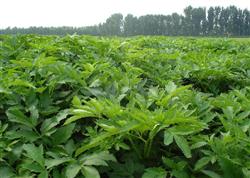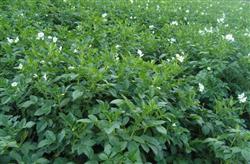How to manage Angelica dahurica to achieve high yield?

How does Angelica dahurica manage to get high yield? Please give advice to plant Angelica dahurica want to obtain high yield should pay attention to management, the following Angelica dahurica management methods for reference: 1. Thinning and seedling fixing: Angelica dahurica seedlings grow slowly, and generally do not thin seedlings in the same year of sowing. After returning to green in early spring of the next year, the seedlings are about 5-7 cm high for the first time, and the thin seedlings are over-dense. For drilling, leave one plant at intervals of about 5 cm, for hole seeding, leave 5-8 plants per hole; for the second thinning, leave one plant at intervals of about 10 cm or 3-5 plants per hole. Before and after Qingming seedling height of about 15 cm when the seedlings, plant spacing 13-15 cm or 3 per hole, triangular staggered, in order to facilitate ventilation and light transmission. When determining seedlings, large seedlings with excessive growth and bluish white petioles should be pulled out to prevent early flowering. Second, intertill weeding: it is best to combine thinning and seedling determination at the same time. When the leaves grow up and the ridge surface is closed, there is no need to weed again. Third, topdressing: Angelica dahurica is a relatively fertile crop, but generally before spring should be less or no fertilizer, in case the seedling growth is too prosperous, early flowering. After spring, nutrient growth begins to flourish, and topdressing can be applied 3-4 times. The first and the second time are carried out after thinning and intertillage, and the third and the fourth time are carried out after seedling determination and before ridge sealing. Fertilization should be carried out on sunny days, and fertilization should not be carried out on the day after rain or weeding. Fertilizer types can be selected from human manure, decomposed cake fertilizer, manure, urea and so on. For the first time, fertilizer should be thin and less, such as 10 loads of diluted human and animal manure per mu, and gradually increase the concentration later, such as 30-40 loads. Before closing the ridge, phosphorus and potassium fertilizer can be applied once, such as calcium superphosphate 20-25 kg, to promote root thickening. It has been reported that 25 kg of calcium magnesium phosphate and 5 kg of potassium chloride were applied in a topdressing before ridge closure, and soil cultivation immediately after application could prevent lodging and promote growth. The number of topdressing and the amount of fertilizer each time can also be determined according to the growth of the plant. If the leaf color of the plant is light green and not too vigorous when the ridge is about to be closed, topdressing can be performed again, or the leaf color is dark green and the growth is vigorous, so it can not be chased. IV. Drainage and Irrigation Baizhi likes water, but is afraid of standing water. After sowing, if the soil is dry, it should be watered immediately. If there is no rainy day, it should be watered once every few days to keep the ridge surface wet before the seedlings emerge, so as to facilitate seedling emergence; The soil should also be kept moist at seedling stage to prevent yellow leaves from appearing and more lateral roots from being produced; The seedlings should be watered thoroughly before overwintering. Henan has the experience of "wet freezing is best, dry freezing is not easy to live," Hebei has the experience of "Angelica dahurica only dies in winter, but does not freeze to death." After the spring of the following year can be combined with topdressing timely irrigation, especially in the hot days should maintain sufficient water. In case of rainy season, ponding in the field, ditch drainage should be timely to prevent ponding rotten roots and diseases. 5. Remove the sprouts In May of the second year after sowing, some plants will sprout and bloom. Their roots cannot be used for medicinal purposes, and their seeds cannot be used as seeds, because their next generation will sprout ahead of time. Therefore, in order to reduce the consumption of nutrients in the field, the plants found to sprout should be removed in time. Click to get more Angelica dahurica planting technology Click to get more herbs planting technology
- Prev

How does Angelica dahurica grow and manage?
How does Angelica dahurica grow and manage? Please introduce angelica dahurica Angelica dahurica is suitable to grow in sandy loam and loam with flat terrain, deep, loose, fertile and well-drained soil. 1. Sowing: Angelica dahurica in spring before and after the Qingming Festival and in autumn from the End of Heat to White Dew.
- Next

How to manage planting Angelica dahurica?
How to manage planting Angelica dahurica? Please introduce and guide the management methods of planting Angelica dahurica. Interseedling and fixed seedling. Angelica dahurica seedlings grow slowly, generally not thinning seedlings in the year of sowing. After turning green in the early spring of the second year, the seedlings are carried out for the first time when the height is about 5mi 7cm, and the thin seedlings are too dense. Broadcast on the Internet.
Related
- Fuxing push coffee new agricultural production and marketing class: lack of small-scale processing plants
- Jujube rice field leisure farm deep ploughing Yilan for five years to create a space for organic food and play
- Nongyu Farm-A trial of organic papaya for brave women with advanced technology
- Four points for attention in the prevention and control of diseases and insect pests of edible fungi
- How to add nutrient solution to Edible Fungi
- Is there any good way to control edible fungus mites?
- Open Inoculation Technology of Edible Fungi
- Is there any clever way to use fertilizer for edible fungus in winter?
- What agents are used to kill the pathogens of edible fungi in the mushroom shed?
- Rapid drying of Edible Fungi

